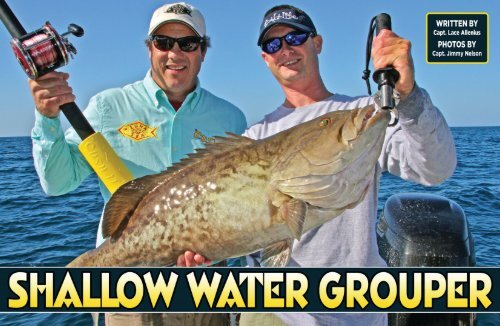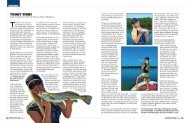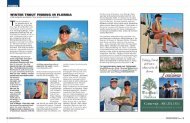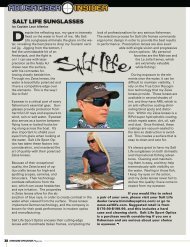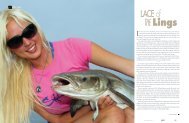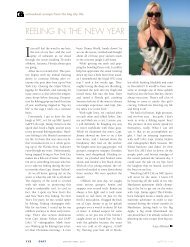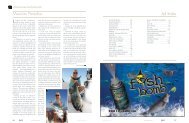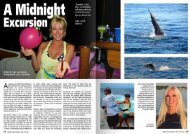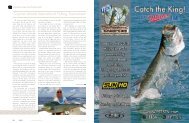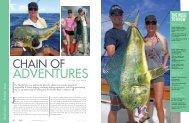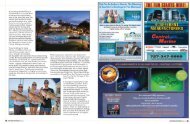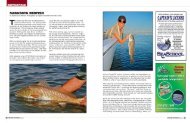Shallow Water Grouper
You also want an ePaper? Increase the reach of your titles
YUMPU automatically turns print PDFs into web optimized ePapers that Google loves.
Struggling against the forcefully bent<br />
rod, breathing heavily while fighting<br />
whatever is pulling from the depths<br />
below and straining for the chance at<br />
victory offers Florida anglers an exhilarating<br />
challenge year after year. Eager fishermen<br />
venture out for the thrill of the hunt, armed<br />
with the best methods and equipment they<br />
can muster. Scouring the areas where their<br />
targeted prey can be found, they share a common<br />
goal when on this mission: Pulling up a<br />
fat, whopping grouper to bring into the boat<br />
or home to the table.<br />
<strong>Shallow</strong> water grouper fishing is excellent up<br />
and down both coasts of Florida. This sport<br />
takes some knowledge to get it right, but once<br />
the techniques are learned, grouper fishing<br />
can prove to be very fruitful. Fresh grouper is<br />
a staple in the seafood diet of most Floridians.<br />
Even if one doesn’t enjoy eating this delicious<br />
fish, fighting them is always a treat!<br />
Most of the shallow water grouper found in<br />
Florida are Gags, but once in a while you’ll pull<br />
up an occasional Red or Black grouper. From<br />
land, grouper can be found around bridges,<br />
barge canals and docks. These are the places<br />
to fish for grouper because they congregate<br />
next to permanent areas of shelter. When on<br />
a boat, looking for structure on a fish finder<br />
can be helpful when trying to find the spots<br />
where grouper are hiding. Structures such as<br />
reefs and wrecks overflow with threadfins, sardines<br />
and smaller reef fish. <strong>Grouper</strong> live in and<br />
around these structures, not only for protection,<br />
but also for the bountiful supply of food.<br />
It’s nice that Florida grouper can be caught<br />
from land and also by boat. This makes grouper<br />
fishing even more enticing for any kind of<br />
last minute fishing trip!<br />
The best water temperatures to catch grouper<br />
in range from the mid 60-80 degrees Fahrenheit.<br />
The fish prefer this temperature range,<br />
making Florida a prime location for catching<br />
them year round, however, the most favorable<br />
water temperatures for shallow water grouper<br />
fishing occur during spring and fall in most<br />
areas of the state. In the winter, the water is<br />
colder which makes them lethargic. During<br />
the summer, the water temperatures are hotter,<br />
which slows them down as well. <strong>Grouper</strong><br />
move out to deeper water to find more favorable<br />
water temperatures during winter and<br />
summer, making them harder to find when<br />
fishing in shallow water.<br />
are while dragging their lures behind the boat.<br />
In this case, artificial bait is usually best and<br />
anglers use species-specific lures in order to<br />
attract grouper. When trolling, the grouper<br />
will see the lure, come up from the structure<br />
they are hanging around, and inhale the lure.<br />
Trolling for grouper is great because it eliminates<br />
much of the risk of the fish swimming<br />
back underneath the rocks, reef or wreck.<br />
Trolling covers a lot of territory, and if you<br />
don’t know exactly where the grouper are, it’s<br />
a great way to locate the fish as well as look<br />
for new spots. The Yo-Zuri deep diving Crystal<br />
Minnow is a great lure to use. These lures<br />
dive about fifteen to twenty feet, so a good<br />
depth of water to troll is between fifteen and<br />
thirty feet over shallow rocks, wrecks, reefs, or<br />
potholes. The nice thing about these types of<br />
lures is that they look a lot like Spanish sardines,<br />
speedos, or threadfins that hang around<br />
wrecks.<br />
Anglers generally use conventional tackle with<br />
a heavier grouper rod when trolling. Most<br />
people use 50 to 60 pound<br />
mono line with a fairly<br />
tight drag because you<br />
don’t want the grouper<br />
to be able to pull drag<br />
and run under a rock.<br />
The idea is to stop<br />
the grouper in<br />
its tracks and<br />
immediately<br />
pull the fish<br />
towards the<br />
boat.<br />
If you give a grouper ten feet of line, you’ve<br />
generally lost your fish.<br />
When trolling, one can imagine the grouper<br />
popping up from its rocky hole to attack the<br />
bait and then being yanked forward. All of<br />
this hopefully happens before the grouper<br />
gets a chance to swim back down and break<br />
the line on the rocks. Trolling is a marvelous<br />
technique. Once an angler gets to know the<br />
way grouper behave, it becomes easier to figure<br />
out how to catch them.<br />
Get ready; because when you get<br />
a grouper on your trolling rod,<br />
it’s going to be a hard hit.<br />
The pole will bend suddenly<br />
and it will be obvious a<br />
grouper<br />
has swallowed<br />
the bait.<br />
It’s<br />
Two of the most common methods for catching<br />
shallow water grouper are trolling and<br />
jigging. Trolling involves fishermen slowly<br />
driving their boat over the area where the fish<br />
26 ONSHORE-OFFSHORE Magazine
not always necessary to take the pole out of<br />
the rod holder when you start reeling. Cranking<br />
as soon as the fish hits the line can be effective<br />
as well. Pull the rod out once you get<br />
the grouper closer to the boat. At this point,<br />
it’s best to have a Cush-It ready to slip onto<br />
the rod butt so it doesn’t dig into your hip<br />
during the fight.<br />
While trolling for shallow water grouper, you<br />
may run into Kingfish, Spanish Mackerel and<br />
Cobia. These are all fantastic by-catches. I<br />
always love to fill my Grizzly cooler with as<br />
many fish as possible. Once you’ve found<br />
grouper while trolling, it’s not a bad idea to<br />
kill the engine and start jigging because there<br />
are likely to be other fish congregating nearby.<br />
It’s helpful to mark these spots on your bottom<br />
machine, so you can come back and fish<br />
them later.<br />
Jigging is a great way to specifically target<br />
grouper after locating them by trolling. Jigging<br />
is a method used when the boat is<br />
anchored or drifting with the engines off. To<br />
jig, anglers simply drop their lines down and<br />
bounce the lure upward from the bottom,<br />
hoping to get a bite. After dropping the line<br />
beside the boat, it’s important to let the jig<br />
sink all the way to the bottom. Sometimes,<br />
it can be tricky to know when to close the<br />
bail, so it’s necessary to feel the bait hit bottom<br />
and see slack in your line. Drop a bucktail<br />
jig or a Tsunami Holographic Swim Bait<br />
to trigger the bite you’re after. <strong>Grouper</strong> will<br />
see the bait near the bottom and pop out of<br />
the rocks in order to snatch a meal. It’s good<br />
to use baits with holographic components<br />
because they reflect light coming from the<br />
surface, better illuminating the lure for the<br />
bottom-dwelling grouper.<br />
To the grouper, the jig looks like a crab or<br />
shrimp or baitfish shooting up from the bottom<br />
and fluttering back down to the floor.<br />
<strong>Grouper</strong> also can hear this activity and see the<br />
puff of sand each time the bait is jigged from<br />
the bottom. Besides jigging with lures, live<br />
or natural bait is something that will work on<br />
grouper if they seem to be a little stubborn on<br />
the artificial bait. Once you find a spot with<br />
grouper, work this area strongly before trolling<br />
over another area to find more fish.<br />
Jigging for grouper is best on 65 or 80 pound<br />
braid with a 60 or 80lb Yo-Zuri power carbon<br />
leader. The reason that your line and leader<br />
needs to be so heavy is because you’re usually<br />
fishing around rocks, reefs, wrecks or ledges.<br />
The drag should be pretty tight while jigging,<br />
just as when trolling for grouper. It’s always<br />
important to keep reeling once the hook is set<br />
because grouper will quickly swim back under<br />
the rocks and snap the line. <strong>Grouper</strong> fight<br />
hard, and it’s always a struggle to keep your<br />
rod up while excitedly reeling in!<br />
Sometimes, if a grouper swims under the<br />
rocks, anglers wait until the fish loosens itself<br />
before resuming the fight. This is when you<br />
may get a lucky second chance to pull him<br />
up from the rocks and into the boat! <strong>Grouper</strong><br />
fishing is completely different than fighting a<br />
fish in the open water. You can afford to have<br />
a looser drag when fighting a pelagic in blue<br />
water or fishing on the flats, because there<br />
isn’t much structure to cut your line.<br />
Jigging and trolling are two of the oldest<br />
techniques for catching grouper with lures.<br />
These methods have been tried and true for<br />
decades, and it’s best to trust the solid advice<br />
of Florida fishermen that’s been years in the<br />
making. Essentially, there is no need to reinvent<br />
the wheel. Jigs and trolling lures are very<br />
effective for catching grouper, just like gold<br />
spoons are great for catching redfish.<br />
Currently, there is an overabundance of Gag<br />
grouper on the west coast of Florida. With<br />
the long closures on the legal fishing season,<br />
grouper are starting to overpopulate most<br />
gulf areas. This rapid increase in population<br />
has made catching Gag grouper much easier<br />
for Florida anglers. With the current season<br />
opening up again, Gag grouper are a muchawaited<br />
target for many Florida anglers.<br />
<strong>Shallow</strong> water grouper fishing has become<br />
a favorite pastime for many Florida fishermen.<br />
These fish are a long sought-after delicacy<br />
and they make a delightful dinner when<br />
freshly prepared. Targeting grouper is very<br />
easy if you know the right techniques, and it’s<br />
not hard to find them if you know where to<br />
look. The thrill of a solid hit slamming the rod,<br />
gut-busting battles on top of rocky structures<br />
and skillful execution of time-tested methods<br />
keeps grouper fishing in Florida booming all<br />
year round.<br />
28 ONSHORE-OFFSHORE Magazine ONSHORE-OFFSHORE Magazine 29


